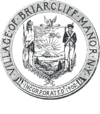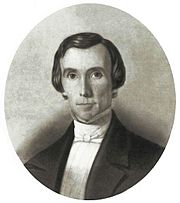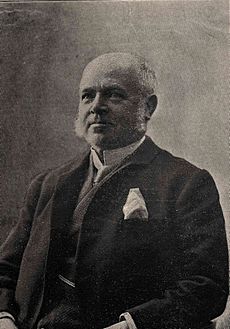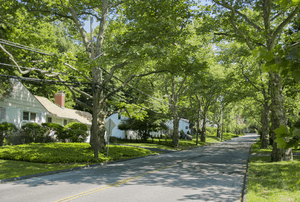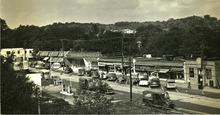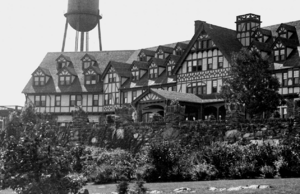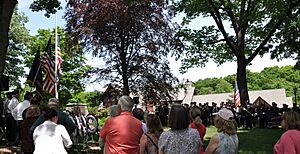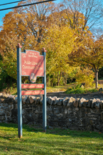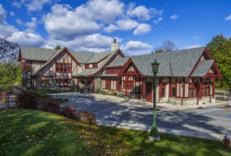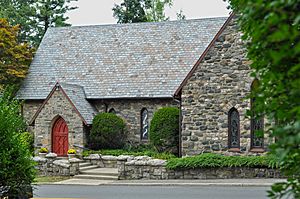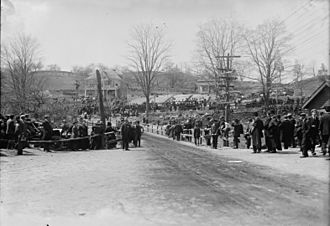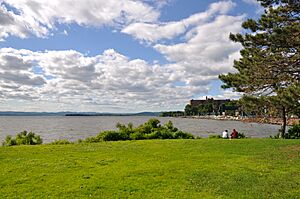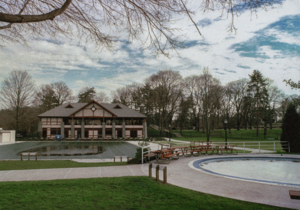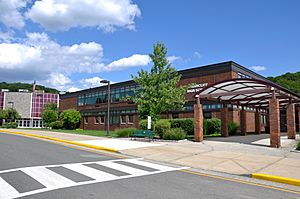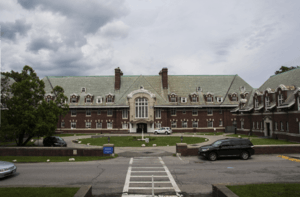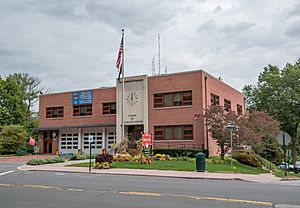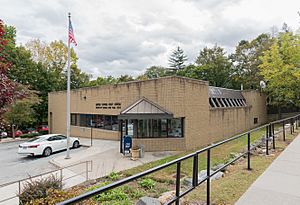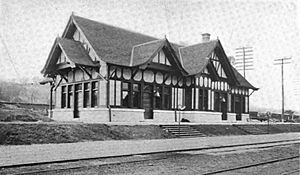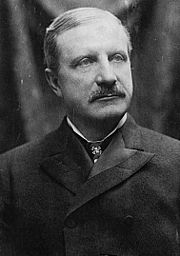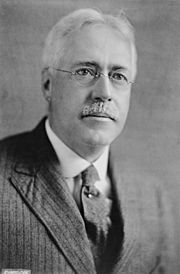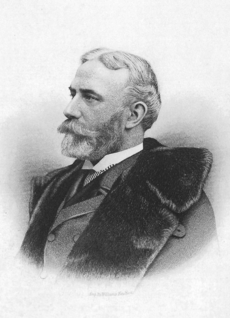Briarcliff Manor, New York facts for kids
Quick facts for kids
Briarcliff Manor, New York
Village of Briarcliff Manor
|
|||
|---|---|---|---|
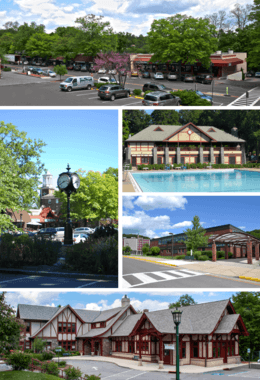
Clockwise from top: the Village Center; village pool at Law Memorial Park; Briarcliff High School; Briarcliff Manor Public Library; village clock and Municipal Building.
|
|||
|
|||
| Nickname(s):
Briarcliff
|
|||
| Motto(s):
A village between two rivers
|
|||

Interactive map of Briarcliff Manor's location
|
|||
| Country | United States | ||
| State | New York | ||
| Region | Hudson Valley | ||
| County | Westchester | ||
| Municipality | Mount Pleasant and Ossining | ||
| Incorporation | 1902 | ||
| Founded by | Walter William Law | ||
| Named for | The Irish family home "Brier Cliff" | ||
| Seat | Briarcliff Manor Village Hall, 1111 Pleasantville Road, 41°08′56″N 73°49′43″W / 41.14889°N 73.82861°W | ||
| Parts | Chilmark and Scarborough | ||
| Government | |||
| • Type | Council-Manager | ||
| Area | |||
| • Total | 6.83 sq mi (17.70 km2) | ||
| • Land | 6.00 sq mi (15.53 km2) | ||
| • Water | 0.84 sq mi (2.17 km2) | ||
| Elevation | 351 ft (107 m) | ||
| Highest elevation
(41°09′24″N 73°50′46″W / 41.15667°N 73.84611°W)
|
533 ft (162 m) | ||
| Lowest elevation | 0 ft (0 m) | ||
| Population
(2020)
|
|||
| • Total | 7,569 | ||
| • Density | 1,262.55/sq mi (487.44/km2) | ||
| Time zone | UTC−5 (EST) | ||
| • Summer (DST) | UTC−4 (EDT) | ||
| ZIP Code |
10510
|
||
| Area code(s) | 914 | ||
| FIPS code | 36-08103 | ||
| GNIS feature ID | 969912, 2391558 | ||
| VIAF code | VIAF: 130216697 | ||
Briarcliff Manor is a village in Westchester County, New York. It is about 30 miles (48 km) north of New York City. The village sits on the east bank of the Hudson River. It covers about 5.9 square miles (15 km2) of land. Briarcliff Manor is part of the towns of Mount Pleasant and Ossining.
The village includes the areas of Scarborough and Chilmark. You can reach it by train at the Scarborough station. A part of the village, with buildings and homes covering 376 acres (152 ha), is a historic area. It was added to the National Register of Historic Places in 1984.
Briarcliff Manor's motto is "A village between two rivers." This shows its location between the Hudson and Pocantico Rivers. Long ago, Wappinger Native American tribes lived here. In the early 1800s, the area was called Whitson's Corners.
Walter William Law moved here in the 1890s. He helped build the village, adding schools, churches, and parks. He also built the Briarcliff Lodge. Briarcliff Manor became a village in 1902. It has grown from 331 people to 7,569 in 2020.
Historically, rich families like the Vanderbilts, Astors, and Rockefellers owned large estates here. Today, it is still mostly residential. The village has about 180 acres (73 ha) of parks and fun places. It has seven Christian churches and two synagogues. The oldest church, Saint Mary's Episcopal Church, was built in 1851.
Briarcliff Manor has its own local government. It has police, fire, and recreation departments. It is known for having a very low crime rate.
Contents
- Exploring Briarcliff Manor's Past
- Briarcliff Manor's Location and Nature
- People and Community in Briarcliff Manor
- Arts, Culture, and History
- Sports and Recreation in Briarcliff Manor
- Education in Briarcliff Manor
- Briarcliff Manor in Media
- Village Services and Transportation
- Famous People from Briarcliff Manor
- See also
Exploring Briarcliff Manor's Past
How Briarcliff Manor Got Its Name
A part of Briarcliff Manor was once called Whitson's Corners. This was named after the Whitson brothers who owned farms there. The corner of Pleasantville and South State roads was where John H. Whitson's house stood.
The nearby area of Scarborough was called Weskora. It was renamed in 1864 after a town in England. When Scarborough joined Briarcliff Manor in 1906, the train station sign said "Briarcliff West." But people in Scarborough were proud of their name. They threw the new sign into the Hudson River and put the old Scarborough sign back up!
The name Briarcliff Manor comes from "Brier Cliff." This was the name of a family home in Ireland. John David Ogilby, a professor, named his summer home in New York Brier Cliff. In 1890, Walter Law bought land here. He used the name Briarcliff for all his property. His friend, Andrew Carnegie, called him "The Laird of Briarcliff Manor." This name stuck, and the village became "Briarcliff Manor."
In 1902, residents voted on the name. "Briarcliff Manor" won over other ideas, like "Sing Sing East." On November 21, 1902, the village was officially created. People sometimes call it "Briarcliff." Its motto, "A village between two rivers," also describes it. Another motto is Walter Law's quote: "Only the best is good enough."
From Early Settlements to Today
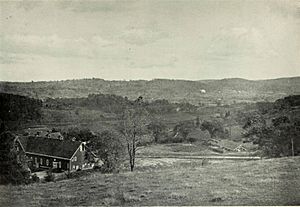
People have lived in the Briarcliff Manor area for a very long time. But the area really started to grow in the 1800s. Before Europeans arrived, the Sint Sincks, a Native American tribe, lived here. In the 1680s, Frederick Philipse bought a huge amount of land from them. He called it Philipsburg Manor.
After the American Revolutionary War, the Philipses lost their land. The area remained mostly empty until after the war.
Walter Law moved to Briarcliff Manor after he retired. He bought his first 236 acres (96 ha) in 1890. He quickly bought more land, owning over 5,000 acres (20 km2) by 1900. Law helped build the village by creating schools, churches, and parks. His farm workers moved into the village. This made the population grow enough for Law to make it an official village. Briarcliff Manor became a village on November 21, 1902.
The beautiful Tudor Revival-style Briarcliff Lodge opened in 1902. It was a fancy resort hotel. Famous guests like Franklin and Eleanor Roosevelt stayed there. The lodge later became a school. Sadly, it burned down in 2003.
The Briarcliff Manor Fire Department started in 1903. Scarborough joined Briarcliff Manor in 1906. The Police Department was formed two years later. The Village Municipal Building opened in 1914. The high school opened in 1928.
In 1953, Todd Elementary School opened. The Putnam Division train line closed in 1958. The Briarcliff Manor Public Library opened in the old train station in 1959. The village celebrated its 100th birthday in 2002 with many fun events. A new part was added to the library in 2009. The old part became the village's community center in 2016.
Briarcliff Manor's Location and Nature
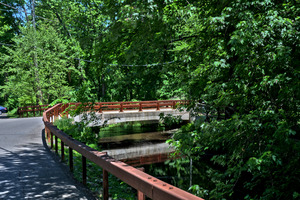
Briarcliff Manor is about 30 miles (48 km) north of Manhattan. It's part of Westchester County. This means it's part of the larger New York City area. It sits on the Hudson River, just north of the Tappan Zee Bridge.
The village covers about 6.7 square miles (17 km2). Most of this is land, with some water. Major streams like Caney Brook, the Pocantico River, and Sparta Brook flow through the village. You can see many rocks like dolomite and granite. Huge boulders were left here by glaciers long ago.
The lowest point in Briarcliff Manor is near the Hudson River. The highest point is about 533 feet (162 m) above sea level. When the village first started in 1902, it was only about 1 square mile (2.6 km2). It grew by adding Scarborough and land from Mount Pleasant.
Weather in Briarcliff Manor
| Weather chart for Briarcliff Manor | |||||||||||||||||||||||||||||||||||||||||||||||
|---|---|---|---|---|---|---|---|---|---|---|---|---|---|---|---|---|---|---|---|---|---|---|---|---|---|---|---|---|---|---|---|---|---|---|---|---|---|---|---|---|---|---|---|---|---|---|---|
| J | F | M | A | M | J | J | A | S | O | N | D | ||||||||||||||||||||||||||||||||||||
|
3.5
35
21
|
3.1
39
23
|
4.5
47
29
|
4.4
58
39
|
4.1
68
49
|
4.3
77
59
|
3.7
82
64
|
4.2
80
63
|
4.7
73
55
|
4.4
62
44
|
4
51
36
|
4.3
40
27
|
||||||||||||||||||||||||||||||||||||
| temperatures in °F precipitation totals in inches source: The Weather Channel |
|||||||||||||||||||||||||||||||||||||||||||||||
|
Metric conversion
|
|||||||||||||||||||||||||||||||||||||||||||||||
Briarcliff Manor has four clear seasons. Winters are cold and snowy. Summers are hot and humid.
Summer high temperatures are usually in the low 80s Fahrenheit (upper 20s Celsius). Lows are in the low 60s F (upper 10s C). The hottest temperature ever recorded was 100 °F (38 °C) in 1995. The coldest was −10 °F (−23 °C) in 1979.
| Climate data for Briarcliff Manor | |||||||||||||
|---|---|---|---|---|---|---|---|---|---|---|---|---|---|
| Month | Jan | Feb | Mar | Apr | May | Jun | Jul | Aug | Sep | Oct | Nov | Dec | Year |
| Record high °F (°C) | 65 (18) |
75 (24) |
82 (28) |
90 (32) |
95 (35) |
97 (36) |
100 (38) |
98 (37) |
98 (37) |
84 (29) |
78 (26) |
72 (22) |
100 (38) |
| Mean daily maximum °F (°C) | 35 (2) |
39 (4) |
47 (8) |
58 (14) |
68 (20) |
77 (25) |
82 (28) |
80 (27) |
73 (23) |
62 (17) |
51 (11) |
40 (4) |
59 (15) |
| Mean daily minimum °F (°C) | 21 (−6) |
23 (−5) |
29 (−2) |
39 (4) |
49 (9) |
59 (15) |
64 (18) |
63 (17) |
55 (13) |
44 (7) |
36 (2) |
27 (−3) |
42 (6) |
| Record low °F (°C) | −9 (−23) |
−10 (−23) |
6 (−14) |
16 (−9) |
32 (0) |
39 (4) |
46 (8) |
41 (5) |
33 (1) |
24 (−4) |
15 (−9) |
−5 (−21) |
−10 (−23) |
| Source: The Weather Channel | |||||||||||||
Exploring Briarcliff Manor's Neighborhoods
The village has different neighborhoods. These include the main business area, Scarborough, and Chilmark.
Scarborough: A Riverside Community
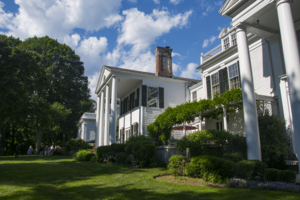
Scarborough is often called Scarborough-on-Hudson because it's right by the river. Most of it is in Briarcliff Manor. It was settled before the Revolutionary War. The area was named after William Kemey's hometown in England.
Scarborough is mostly homes. Some of the most expensive houses in the village are here. This is because they are so close to the Hudson River. You can find condominium complexes like Kemeys Cove and Scarborough Manor. The area has a post office and a train station. Unlike most of Briarcliff Manor, Scarborough is in the Ossining Union Free School District.
In the early 1900s, rich families like the Astors, Rockefellers, and Vanderbilts had large country estates here. The Scarborough Historic District is listed on the National Register of Historic Places. This includes the Scarborough Presbyterian Church. Across from the church is Sparta Cemetery. Here you can find graves of Revolutionary War veterans and the famous Leatherman.
A famous building is Beechwood, built in 1780. It's a great example of Federal architecture. Frank A. Vanderlip later bought Beechwood. He built the Scarborough School on the estate. This school was founded in 1913 and closed in 1978.
Chilmark: A Planned Community
Chilmark is a residential area of about 300 acres (120 ha). It was started in 1930. Underhill Road is its main street. It was named after a village in England.
The Macy family, who were important in New York, helped create Chilmark. Valentine Everit Macy and his wife, Edith Carpenter Macy, founded the community. In 1925, Macy gave 265 acres (107 ha) for the first national Girl Scout camp. This is now the Edith Macy Conference Center. The Briarcliff Recreation Center used to be the private Chilmark Club. The village bought it in the 1970s.
Chilmark has winding roads and homes built in older styles. These homes look like Tudor and Gothic buildings. Macy's son, V.E. Macy Jr., sold land here. He planted special trees along Underhill Road to make the neighborhood feel exclusive.
Village Center: The Heart of Briarcliff
The Village Center is Briarcliff Manor's main business area. It's on Pleasantville Road and North State Road. There are many shops, restaurants, and cafes here. In 1906, there were only three stores!
The village hall and a small park are in this area. It has brick sidewalks and old-fashioned street lights. The Walter W. Law Memorial Park is also nearby. Further east are the three schools of the Briarcliff Manor Union Free School District.
The Village Center has some very old houses. These include the Whitson House, built in the 1770s. The oldest house is Century Homestead, from about 1767.
Central Briarcliff West: Grand Estates
This neighborhood has many large mansions. These were built by rich people in the 1900s. They often stayed at the Briarcliff Lodge first. The lodge itself stood here from 1902 until it burned down in 2003.
The Law family homes are also in this area. These were built in 1902 for Walter Law's children. His own estate, the Manor House, is also here.
The Tree Streets and The Crossroads
The Tree Streets is a group of streets in the Mount Pleasant part of the village. Many are named after trees, like Larch Road and Oak Road. Walter Law planted rows of these trees on the streets. Many houses here were built in the 1930s.
The Crossroads is a group of 84 houses. Its streets are named after local World War II veterans. It was built after the war to provide homes for returning soldiers. It was finished in 1952.
 |
Ossining | Millwood | Chappaqua |  |
| Hudson River | Pleasantville | |||
| Sleepy Hollow | Pocantico Hills | Hawthorne |
People and Community in Briarcliff Manor
Population and Diversity
| Population growth since 1902 | ||||||||||||||
|---|---|---|---|---|---|---|---|---|---|---|---|---|---|---|
| Year | 1902 | 1910 | 1920 | 1930 | 1940 | 1950 | 1960 | 1970 | 1980 | 1990 | 2000 | 2010 | 2019 | 2020 |
| Population | 331 | 950 | 1,027 | 1,794 | 1,830 | 2,494 | 5,105 | 6,521 | 7,115 | 7,070 | 7,696 | 7,867 | 8,094 | 7,569 |
| ±% | — | +187.0% | +8.1% | +74.7% | +2.0% | +36.3% | +104.7% | +27.7% | +9.1% | −0.6% | +8.9% | +2.2% | +2.9% | −6.5% |
| Source: 1902 to 1940 • 1950 to 2000 • 2010 • 2020 | ||||||||||||||
Briarcliff Manor has grown a lot over the years. In 1902, only 331 people lived here. By 2020, the population was 7,569. Most of the land in Briarcliff Manor is for homes. About 99% of the buildings are houses.
In 2010, most residents were white (82.7%). There were also African American (3.3%) and Asian American (8.5%) residents. About 8.2% of the population was Hispanic or Latino.
The village is known for having many wealthy residents. The average household income is high.
Local Economy and Jobs
| Briarcliff Manor | ||
|---|---|---|
| Employment by industry, 2014 | ||
| Industry | Employment | Percentage |
| Education and health care | 919 | 26.5% |
| Professional, scientific, management | 811 | 23.4% |
| Finance, insurance, real estate | 522 | 15.1% |
| Retail and wholesale trade | 423 | 12.2% |
| Arts, entertainment, recreation, food services | 268 | 7.7% |
| Manufacturing | 144 | 4.2% |
| Other services | 116 | 3.3% |
| Information | 110 | 3.2% |
| Construction | 72 | 2.1% |
| Public administration | 36 | 1.0% |
| Agriculture and resource-based | 24 | 6.9% |
| Transportation, warehousing, utilities | 18 | 0.5% |
| Total | 3,463 | 100% |
About five percent of Briarcliff Manor's land is used for businesses. The main shopping area is on Pleasantville and North State Roads. You can find restaurants, cafes, and shops there.
Many jobs in the village are in education, health care, and social services. Most people who work in Briarcliff Manor also live there. The average time people spend commuting to work is about 37 minutes.
Arts, Culture, and History
The village symbol is the Briarcliff Rose. It's a bright version of the American Beauty rose. The Briarcliff Manor Garden Club uses this rose as its symbol. They help plant and care for public gardens.
Briarcliff Manor has many Scouting groups. These include Cub Scouts and Boy Scouts. The first Girl Scout troop started in 1917.
The Briarcliff Manor Community Bonfire is a fun winter event. It has live music, snacks, and crafts for kids. Another yearly event is the Memorial Day parade. This parade has been a tradition for over fifty years. It honors firefighters and veterans.
Preserving Briarcliff Manor's History
Briarcliff Manor cares a lot about its history. In 1974, the Briarcliff Manor-Scarborough Historical Society (BMSHS) was formed. They published a book about the village's history.
In 2010, the BMSHS got a permanent home. It's called the Eileen O'Connor Weber Historical Center. It's part of the Briarcliff Manor Public Library. The historical society helps organize events. These include tours of old homes and churches. They also have bus tours and antique-car shows.
Historic Places to See
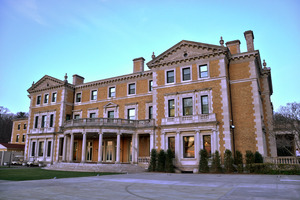
Briarcliff Manor has many historic buildings. Some are on the National Register of Historic Places. These include All Saints' Episcopal Church. Carrie Chapman Catt's house, Juniper Ledge, is also listed. She was a leader in the fight for women's right to vote.
Part of the Old Croton Aqueduct State Historic Park is in the village. The Old Croton Aqueduct is a National Historic Landmark. It's a popular trail for biking and running.
Places of Worship
Briarcliff Manor has seven Christian churches and two synagogues. Three churches are in Scarborough. These are Holy Innocents Anglican Church, Saint Mary's Church, and Scarborough Presbyterian Church.
Saint Mary's Episcopal Church is the oldest church. It was founded in 1839. It has beautiful stained-glass windows. Washington Irving, who wrote "The Legend of Sleepy Hollow", was a parishioner.
Scarborough Presbyterian Church was given to the community in 1895. It was the first church in the U.S. with an electric organ. All Saints' Episcopal Church was founded in 1854. It was designed by Richard Upjohn.
St. Theresa's Catholic Church started in 1926. Its current church building was finished in 1928. Faith Lutheran Brethren Church moved to Briarcliff Manor in 1967.
Briarcliff Congregational Church was built in 1896. It has windows by famous artists like Louis Comfort Tiffany. Walter Law donated the land for this church. He wanted it to be a place for everyone.
Congregation Sons of Israel is the first synagogue in Briarcliff Manor. It started in 1891 in Ossining. It moved to its current location in 1960. Chabad Lubavitch of Briarcliff Manor & Ossining was started around 2004.
Sports and Recreation in Briarcliff Manor
Briarcliff High School has many sports teams. They are called the Briarcliff Bears.
Briarcliff Manor has a history of car racing. The First American International Road Race was held here in 1908. Over 300,000 people watched the race! The winner covered 259 miles (417 km) in five hours.
Another race was held in 1934 by the Automobile Racing Club of America. This was the first amateur race in the United States. In 2008, the village celebrated the 100th anniversary of the first race. They had a parade with about 60 old cars.
Parks and Fun Places
Briarcliff Manor has about 180 acres (73 ha) of parks. Everyone can use them. The village's recreation department plans fun activities.
Here are some of the parks and facilities:
- The Briarcliff-Peekskill Trailway is a 12-mile (19 km) trail. It runs from the village to Peekskill.
- Chilmark Park has six tennis courts, a basketball court, and fields for soccer and baseball.
- The Hardscrabble Wilderness Area has 235 acres (95 ha) of trails.
- Jackson Road Park has basketball courts and a playground.
- The Old Croton Aqueduct State Historic Park runs through the village. Its 26.2-mile (42.2 km) trail is great for biking and running.
- Pocantico Park is the largest park. It has hiking trails and lots of wildlife.
- Scarborough Park is a 6-acre (2.4 ha) park near the train station. It's surrounded by the Hudson River on three sides.
- The Village Youth Center has a basketball court and indoor space for programs.
- Walter W. Law Memorial Park is in the center of the village. It has a pool complex, tennis courts, and a playground. The pool was the first public swimming pool in Westchester. A memorial to Medal of Honor recipient John Koelsch was built here in 2016.
- The Westchester County Bike Trail is a 22.1-mile (35.6 km) trail. It follows an old railway line.
Briarcliff Manor also has two large country clubs: Sleepy Hollow Country Club and Trump National Golf Club.
Education in Briarcliff Manor
Schools for All Ages
The village has the Briarcliff Manor Union Free School District. It covers most of the village. However, Scarborough and Chilmark are part of the Ossining Union Free School District.
The Briarcliff Manor district serves over 1,000 students. It includes Todd Elementary School, Briarcliff Middle School, and Briarcliff High School. Todd Elementary is named after George A. Todd, Jr., who was the village's first teacher. The middle school was named a "Blue Ribbon School" in 2005.
Briarcliff Manor has been home to many schools over the years. The Scarborough School was the first Montessori school in the United States. It was at the Beechwood estate from 1913 to 1978. Now, The Clear View School uses the site. St. Theresa's Catholic Church also had a school from 1965 to 2013.
Colleges and Higher Learning
The first higher education school was the School of Practical Agriculture and Horticulture. Walter Law helped start it in 1900.
Several colleges have been in Briarcliff Manor. Briarcliff Junior College started in 1903 at the Briarcliff Lodge. It later moved to land Walter Law donated. It became Briarcliff College in 1956. In 1977, Pace University bought Briarcliff College. Pace University used the campus until 2015.
The Edgewood Park School and King's College also used the Briarcliff Lodge property for many years.
Briarcliff Manor in Media
Briarcliff Manor has been featured in books, TV shows, and movies. Parts of James Patterson's novel Honeymoon are set here.
The first episode of Saturday Night Live was filmed in the village's business district in 1975. The show's co-creator, Dick Ebersol, was allowed to film at Briarcliff College for free. The Sleepy Hollow Country Club is also a popular place for filming.
Movies filmed in the village include The Seven Sisters (1915), House of Dark Shadows (1970), and American Gangster (2007). Parts of The Bourne Legacy (2012) were filmed on village roads. The 2013 movie Inside Llewyn Davis filmed at Pace University's Briarcliff campus.
Local newspapers and media outlets include the Briarcliff Daily Voice and the River Journal.
Village Services and Transportation
The Briarcliff Manor Police Department and the volunteer Briarcliff Manor Fire Department are at the Village Hall. The Police Department has 19 officers. The Fire Department Ambulance Corps provides emergency medical help.
Briarcliff Manor has two post offices. One is in the main business district. The other is in Scarborough. The first post office opened in 1881.
Consolidated Edison provides electricity and natural gas. The Briarcliff Manor Department of Public Works provides water from the Catskill Aqueduct. They also maintain roads, vehicles, and remove snow. The village recycles about 53% of its waste.
Getting Around Briarcliff Manor
You can reach Briarcliff Manor by major roads like the Taconic State Parkway, U.S. Route 9, and New York State Route 9A. These roads run north to south. East-west travel can be tricky because some roads are narrow and hilly.
The Metro-North Railroad Hudson Line has a station in Scarborough. This train offers direct service to Grand Central Terminal in New York City. The Bee-Line Bus System also serves areas near the village center.
Train service started in 1880. Walter Law replaced the old train station in 1906. This old station building later became the public library in 1959.
Famous People from Briarcliff Manor
Historical Figures
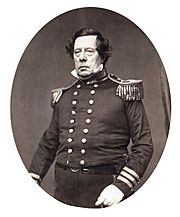
Briarcliff Manor was home to many wealthy families. These included the Rockefellers, Astors, and Macys. William Rockefeller, brother of John D. Rockefeller, lived in Scarborough.
U.S. Naval Commodore Matthew C. Perry, who opened Japan to the West, lived in Scarborough. He helped start Saint Mary's Episcopal Church. Captain Alexander Slidell Mackenzie also lived here. Businessman William Henry Aspinwall lived in Scarborough. He was involved in the Panama Canal. John Lorimer Worden, a U.S. Navy admiral, was born in Scarborough.
Carrie Chapman Catt, a leader for women's right to vote, lived at Juniper Ledge. Frank A. Vanderlip, a bank president, lived at the Beechwood estate. He started the first Montessori school in the U.S.
Ella Holmes White and her friend Marie Grice Young lived at the Briarcliff Lodge. They survived the sinking of the Titanic. Composer Aaron Copland spent time living in Briarcliff Manor. Philanthropist Brooke Astor lived here for much of her life. Children's author C. B. Colby lived on Pine Road.
John Cheever, a famous writer, lived in Scarborough. He was also a volunteer firefighter. John Hersey, a Pulitzer Prize-winning writer, grew up here. He was the village's first Eagle Scout. Folk singer Tom Glazer lived on Long Hill Road for almost 30 years.
Ely Jacques Kahn, Jr., a writer for The New Yorker, lived in Scarborough. His father designed houses in the village. Burton Benjamin, a vice president at CBS News, lived here for 35 years. Richard Yates, a novelist, lived in Scarborough as a boy. He named his novel Revolutionary Road after a local road. Author Alice Low lived in Briarcliff Manor since the 1950s.
The Webb family lived on the Beechwood estate. This included Henry Walter Webb, a railroad executive. James Watson Webb, a diplomat, also lived here. Colonel Elliott Fitch Shepard lived at Woodlea in Scarborough with his wife Margaret Louisa Vanderbilt Shepard.
Contemporary Notable Residents
Many interesting people live in Briarcliff Manor today. Broadway lyricist Lee Adams lives here. Robert Klein, a comedian and actor, has lived here since the 1980s. Robert Mankoff, cartoon editor for The New Yorker, also lives in the village.
Novelist James Patterson is a part-time resident. John Batchelor, a radio news host, lives here with his family. Roz Abrams, a national news anchor, is known for her work on TV. Director Joseph Ruben lives in Briarcliff Manor. Musician Clifford Carter went to Briarcliff High School.
Chef Michael McCarty was born and raised here. Tom Ortenberg, a film executive, also grew up in the village. Doris Downes, a botanical artist, owns a farmhouse here. Radio journalist Kai Ryssdal is from Briarcliff Manor. Curlers Bill Stopera and his son Andrew Stopera live in the village. Baseball player Bobby Blevins grew up here. Olympic swimmer Paola Duguet also grew up in Briarcliff Manor.
See also
 In Spanish: Briarcliff Manor para niños
In Spanish: Briarcliff Manor para niños


